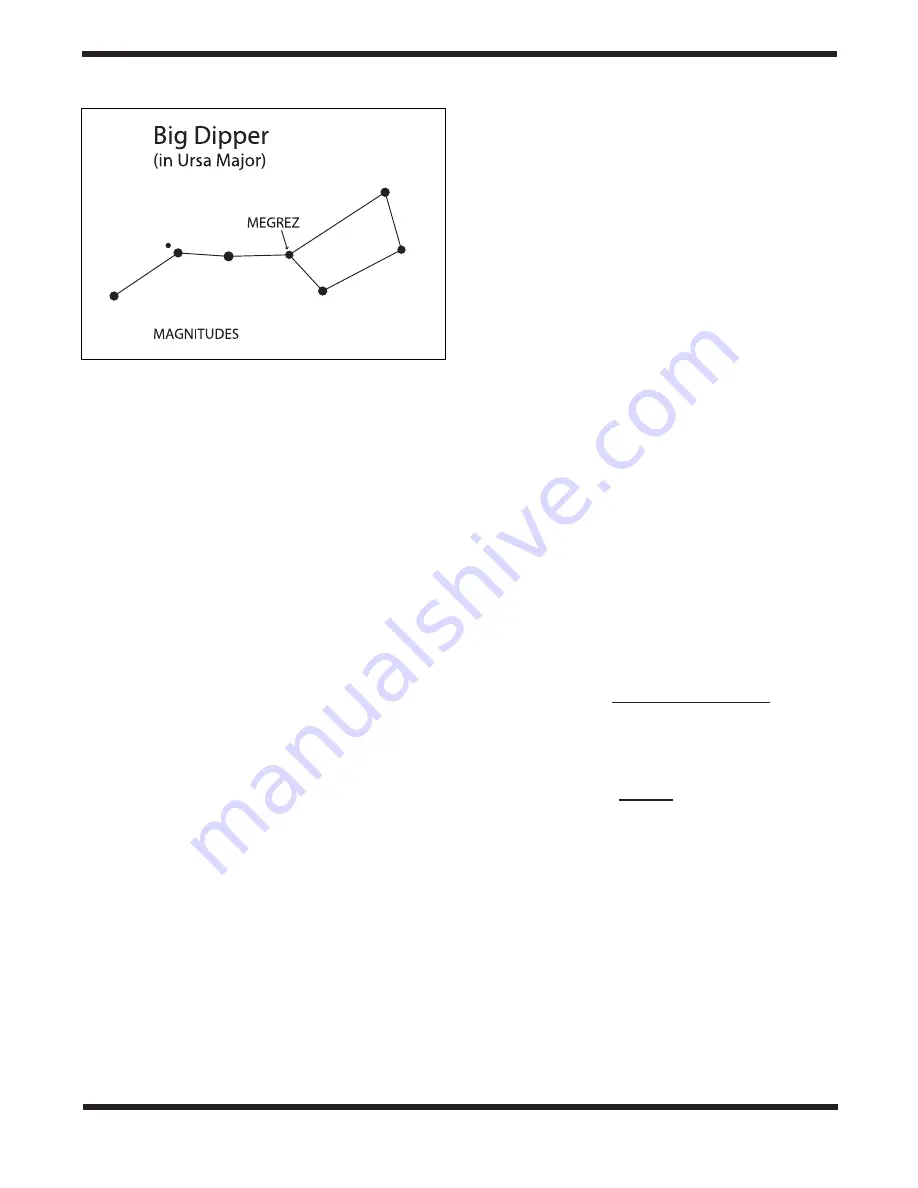
12
If at all possible, escape the light-polluted city sky and head
for darker country skies. You’ll be amazed at how many more
stars and deep-sky objects are visible in a dark sky!
“Seeing” and Transparency
Atmospheric conditions vary significantly from night to night.
“Seeing” refers to the steadiness of the Earth’s atmosphere
at a given time. In conditions of poor seeing, atmospheric
turbulence causes objects viewed through the telescope to
“boil”. If, when you look up at the sky with just your eyes, the
stars are twinkling noticeably, the seeing is bad and you will
be limited to viewing with low powers (bad seeing affects
images at high powers more severely). Planetary observing
may also be poor.
In conditions of good seeing, star twinkling is minimal and
images appear steady in the eyepiece. Seeing is best over-
head, worst at the horizon. Also, seeing generally gets better
after midnight, when much of the heat absorbed by the Earth
during the day has radiated off into space.
Especially important for observing faint objects is good
“transparency”—air free of moisture, smoke, and dust. All
tend to scatter light, which reduces an object’s brightness.
Transparency is judged by the magnitude of the faintest stars
you can see with the unaided eye (6th magnitude or fainter is
desirable).
One good way to tell if conditions are good is by how many
stars you can see with your naked eye. If you cannot see
stars of magnitude 3.5 or dimmer then conditions are poor.
Magnitude is a measure of how bright a star is, the brighter a
star is, the lower its magnitude will be. A good star to remem-
ber for this is Megrez (mag. 3.4), which is the star in the “Big
Dipper” connecting the handle to the “dipper”. If you cannot
see Megrez, then you have fog, haze, clouds, smog, or other
conditions that are hindering your viewing (Figure 13) .
Cooling the Telescope
All optical instruments need time to reach “thermal equilibri-
um.” The bigger the instrument and the larger the tempera-
ture change, the more time is needed. Allow at least 30 min-
utes for your telescope to cool to the temperature outdoors.
Let Your Eyes Dark-Adapt
Don’t expect to go from a lighted house into the darkness of
the outdoors at night and immediately see faint nebulas,
galaxies, and star clusters—or even very many stars, for that
matter. Your eyes take about 30 minutes to reach perhaps
80% of their full dark-adapted sensitivity. As your eyes
become dark-adapted, more stars will glimmer into view and
you’ll be able to see fainter details in objects you view in your
telescope.
To see what you’re doing in the darkness, use a red-filtered
flashlight rather than a white light. Red light does not spoil
your eyes’ dark adaptation like white light does. A flashlight
with a red LED light is ideal, or you can cover the front of a
regular incandescent flashlight with red cellophane or paper.
Beware, too, that nearby porch and streetlights and car
headlights will ruin your night vision.
Eyepiece Selection
By using eyepieces of varying focal lengths, it is possible to
attain many magnifications with the ShortTube 4.5 EQ. Your
telescope comes with two Explorer II eyepieces, a 25mm
that gives a magnification of 40x, and a 10mm that gives a
magnification of 100x. Other eyepieces can be used to
achieve higher or lower powers. It is quite common for an
observer to own five or more eyepieces to access a wide
range of magnifications. This allows the observer to choose
the best eyepiece to use depending on the object being
viewed.
To calculate the magnification, or power, of a telescope and
eyepiece combination, simply divide the focal length of the
telescope by the focal length of the eyepiece:
focal length of telescope
Magnification =
focal length of eyepiece
For example, the ShortTube 4.5 EQ, which has a focal length
of 1000mm, used in combination with the 25mm eyepiece,
yields a power of:
1000mm
= 40x
25mm
Every telescope has a useful magnification limit of about
45x-60x per inch of aperture (which means magnifications of
200x-270x for the ShortTube 4.5 EQ). Claims of higher
power by some telescope manufacturers are a misleading
advertising gimmick and should be dismissed. Keep in mind
that at higher powers, an image will always be dimmer and
less sharp (this is a fundamental law of optics). The steadi-
ness of the air (the “seeing”) can also limit how much magni-
fication an image can tolerate.
Whatever you choose to view, always start by inserting your
lowest-power (longest focal length) eyepiece to locate and
center the object. Low magnification yields a wide field of
view, which shows a larger area of sky in the eyepiece. This
makes acquiring and centering an object much easier. If you
try to find and center objects with high power (narrow field of
Figure 13.
Megrez connects the Big Dipper’s handle to its “pan”.
It is a good guide to how conditions are. If you can not see Megrez
(a 3.4 mag star) then conditions are poor.
2.4
1.7
3.4
2.4
4.9
1.9
1.9
2.5
Summary of Contents for ShortTube 4.5 EQ 9849
Page 15: ...15 ...
























